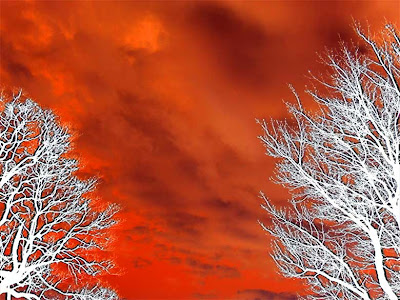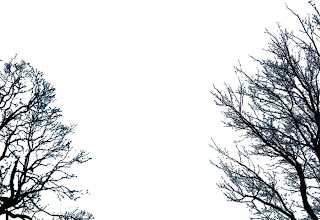
Click on the link to post your own image
or see what others have posted.

Click on the link to post your own image
or see what others have posted.




 The Photo
The Photo 1. In Photoshop, I selected a branch with the magic wand, then chose "similar". In this way, I was able to select all of the branches and copy them to a separate layer.
1. In Photoshop, I selected a branch with the magic wand, then chose "similar". In this way, I was able to select all of the branches and copy them to a separate layer.
 I removed my trench coat and hung it on an empty clothes tree.
I removed my trench coat and hung it on an empty clothes tree.
and
and
Click on the links to post your own entries
or see what others have posted.
Click on image for larger view.
"THE FOOTBRIDGE"
Each day brings feet
Across my planks
Transporting hordes
Between the banks.
They stroll and tramp,
They jog and hike
Across the stream,
They walk and bike.
Foliage peeks through
My rustic rails
To greet my guests
On walking trails.
Fresh leaves invite
Folks to slow down
To view the day
In her green gown.

STORMY WEATHER Part 2
Short Fiction
It was barely light enough to see my way around the house. We should have kept a flashlight in a set location, but I couldn’t find one anywhere. I was on the verge of panic, feeling like I was up the creek without a paddle. In a way I was. Hurricane Ruth had caused Maple Creek to overflow and it was coming my way.
The last thing I had seen on TV before the power went out was a wall of water sweeping a news reporter off her feet. Sirens blared. Through the window, I saw flashing lights from emergency vehicles reflected in the windows of houses closer to the creek. Aurora Lane rose slightly at our end, so I hoped the water would not rise enough to reach the house. It was still raining hard.
I plowed through every drawer and closet in the house, eventually finding two huge scented candles in glass containers. I never used candles because I thought they were fire hazards, but I had received several as gifts ---useless I thought, until I needed them. The apple pie aroma would have been great under different circumstances.
I hadn’t heard from Parker. I tried my own cell phone. It worked, but I couldn’t get through to my husband.
I called my sister Marigold. Parker always referred to Mari as the Green Goddess, because while he and I had black thumbs, Marigold could make a palm tree grow at the north pole. She was scheduled to fly in the following week to visit and help me plant an herb garden. Parker called her annual garden-project visit Operation Marigold.
Mari lived 500 miles to the west. The storm was just a gentle rain in her area. My sister worked for a cell phone company and assured me towers have back-up generators and batteries, but, she explained, each tower can hold only so many calls. During a major storm, they can't accommodate the overload. We finalized our plans for the next week, provided we weren’t under water.
I swear my sister would make a good senator. She could single-handedly keep a filibuster going for a week. Our phone conversations usually ran for hours, but I rang off after thirty minutes, explaining I needed to move things to higher ground.
Our home sat on a hill. The water would have to rise five feet above the street to enter the basement, but if it did the computer equipment I used as a freelance graphic artist in our family room would be ruined. By the light of my two candles, I unplugged the computers, scanners, monitors, and printers, placing them on the highest steps I could reach. I gathered all the small items, the mouse, keyboard, wires, papers, backup disks and external drives into a large box and carried it upstairs.
Every few minutes, I looked to see what was happening outside while I tried to reach Parker. Each time, the water seemed closer than the last time, but since there were no street lights, it was difficult to tell. By then, water was probably more than a foot deep where Aurora met Washington, the only way to drive to our house which sat at the dead end of Aurora. I tried calling my husband again. The call went to voice mail. I hit the redial, saying to myself, “Please answer, please, please, please” and “Thank you,” when he finally picked up. He had just pulled into the school parking lot two blocks from home.
 “What’s going on out there?” I asked.
“What’s going on out there?” I asked.
“Traffic was crazy. They have Washington blocked off.”
“I thought they would. Did you hear anything about that the reporter?”
“The radio said she broke her wrist. Except for a few other bruises, she'll be okay."
I waited at the window until I saw a flashlight bouncing up the street. I opened the garage door to find Parker, soaked trench coat over trousers folded to his knees, his shoes, socks, and the flashlight from the car in hand.
“Come see,” he said, setting his shoes on the garage floor. I rolled up the legs of the pajamas that I had put on after being soaked in the rain earlier. I pulled on Parker’s high rubber boots and the rain slicker I had hung in the garage to dry.
The water had reached the bottom of our driveway. We waded down the street until the ubiquitous water reached mid-calf. We could hear the distant motor of a generator. By flashlight, we saw the creek had flooded basements and was inching up porch steps. It looked like everyone close to the creek had evacuated. I could only imagine the messes they would return to after the storm. I wanted to cry.
“Let’s get inside,” I said. “I’m freezing.” On the way back to the house, the rain died to a drizzle, but we knew that water from the surrounding hills would still flow into the creek which might continue to rise for hours.
Parker had been walking through water that might have overflowed from sewers, so he wanted to shower. He dumped his wet clothes on the garage floor and pulled me toward the bathroom where I peeled off my PJs and jumped into the shower with him. Quickly, we soaped and applied shampoo, then rinsed before the warm water ran out.
Parker put on fresh jeans and T-shirt while I opted for spandex leggings and a turtleneck. We ate sandwiches at my work table in the family room. Parker occasionally took the flashlight to the door to see the water creeping up the driveway. He lit a fire while I anxiously watched the water lapping at the sliding glass doors where the basement floor was at its lowest point. At first water seeped into the room only an inch from the doors, then three, then seven. After we moved the first three pieces of furniture upstairs, the water stopped inching forward and began to recede.
The power was still off. With our hectic schedules, it was a rare treat to prop ourselves on throw pillows in front of the fire and talk for hours like we used to do. We sipped mugs of hot tea, made with water heated in the fireplace.
In front of the fire, my husband’s face looked soft and young. His clothes took on a warm glow. His wedding ring sparkled with orange light. When he looked at me, Parker’s eyes reflected flames as if they, too, were on fire.

 Everyone dressed up to go clothes shopping at department stores downtown. There were few shopping malls. I wore a “Sunday”dress, a fashionable hat, heels (with a matching purse), stockings, my best coat (in season) and white gloves. Department stores would deliver purchases to our home. (Age 16 ---my mother would have been mortified if I'd forgotten my white gloves.)
Everyone dressed up to go clothes shopping at department stores downtown. There were few shopping malls. I wore a “Sunday”dress, a fashionable hat, heels (with a matching purse), stockings, my best coat (in season) and white gloves. Department stores would deliver purchases to our home. (Age 16 ---my mother would have been mortified if I'd forgotten my white gloves.)

